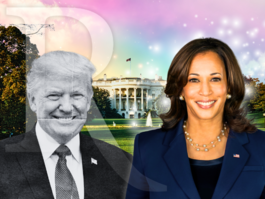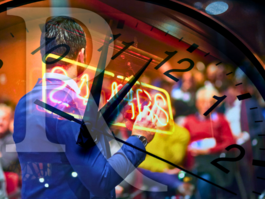Democrats 2016: Biden His Time
A Commentary By Kyle Kondik
If there’s a Clinton crash, the vice president might not be the only one who exploits it
It’s time to ask a question, the answer to which we do not know: Will former Secretary of State Hillary Clinton’s private email server scandal do fatal damage to her campaign?
Over the past few months it’s become clearer that the questions surrounding Clinton’s emails — and a corresponding flood of negative press that she has been unable to counteract — have done her considerable harm, at least in the short term. Her favorability rating has continued to erode, In June, we noted that despite months of questions about her emails — the story broke in early March — Clinton’s net favorability had only gone from 48%-46% favorable to 46%-48% unfavorable, according to HuffPost Pollster’s average. Since then, her unfavorability has only inched up to 49%, but her favorability has dropped to about 41%.
The fact that her unfavorability number hasn’t grown much while her favorability number has clearly dropped suggests that some Democrats and Democratic-leaning independents are not willing to say they like their party’s frontrunner right now, but they also aren’t willing to say they dislike her. These are the voters that Clinton, as the nominee, would probably be able to bring back into the fold. Polarization raises the floor for candidates of both parties, even ones who are damaged.
So perhaps the damage is only temporary.
However, it’s possible to imagine that the email scandal could get so bad that it would drive Clinton from the race. It’s certainly not something we’d predict right now, but we also can’t rule it out. Not when the FBI is sniffing around and Clinton felt compelled, after months of stalling, to turn over her private server, and when there are indications that those tens of thousands of emails she deleted might be retrievable on a backup server.
Clinton could be brought down by facts about the emails we don’t know. Her secretive behavior has reinforced preexisting suspicions, as she’s reminded voters of the consistent scent of scandal that has hung around the Clintons ever since they arrived on the national scene. Like so many other Clinton scandals, this one might roll off their backs. Or it might be the one that sticks.
If Clinton does leave the race, then Katie, bar the door: Every Democratic governor and senator will look in the mirror and see a future president.
However: If she remains in the contest, which is still highly probable, we continue to believe Clinton is a very formidable favorite for her party’s nomination.
Our argument for Clinton’s primary strength is largely unchanged from last month, and we won’t reiterate those points here in detail. The case for Clinton, in short, is this: Party leaders still overwhelmingly support Clinton over any other contenders; the impressive crowds that Clinton’s chief rival, Sen. Bernie Sanders (VT), has been attracting have no predictive value; Clinton is widely supported by Democratic women and minorities, both of whom have a dominant say in the primary process; and the primary calendar suggests looking beyond the very white, unrepresentative opening contests of Iowa and New Hampshire to the more diverse contests that follow, where Clinton should be stronger than Sanders.
But what if Clinton’s perceived weakness draws other candidates into the race even as she remains? This brings us to the rumor of the moment: a potential run by Vice President Joe Biden.
Dartmouth College’s Brendan Nyhan, a shrewd analyst who has contributed to the Crystal Ball, recently argued that Biden already is running. Not because he has announced a decision, but because the growing media buzz around his potential candidacy is a way for Biden and his allies to “test the waters.” If donors, elected Democratic officials, and others are receptive to his candidacy, Biden might actually run. If they are not, he won’t.
In effect, Biden is doing what 2012 Republican nominee Mitt Romney did at the start of 2015, when he semi-publicly considered a candidacy. The reaction among GOP elites to a third Romney run was mixed at best, so Romney passed. If Biden does run, it will tell us that Democratic elites are less sold on Clinton than her long list of endorsements from sitting party officials would suggest, and that the email scandal and her declining favorability have done her harm.
But just because a Biden run would add to Clinton’s mounting list of woes doesn’t automatically mean Biden is a truly serious threat to win the nomination.
As a candidate, Biden would find himself in an unenviable situation. So long as Clinton remains in the race, Biden would have to contend with her daunting funding, organization, and popularity in the party (which remains quite strong). And if Clinton is not in the race, it is unlikely Biden would have to contend only with Sanders, former Gov. Martin O’Malley (MD), and the other existing candidates: As noted above, a Clinton-less field could entice several others to launch a late entrance. It’s unclear whether Biden would be the favorite in a reshuffled Democratic presidential scrum.
That’s because, for a sitting vice president, Biden is unintimidating.
Throughout the entire presidential cycle — going all the way back to 2013 — Clinton has led every single national poll of Democrats, and even in her weakened state her level of support in every poll is near or over 50%. Biden, on the other hand, has never reached even 20% in any national primary poll included in RealClearPolitics’ list, and his average in the most recent surveys is 12%. That strikes us as a fairly weak number for a sitting vice president who did not, unlike former Vice President Dick Cheney, frequently and loudly insist he was not considering a run for president. There just has not been much grassroots support for Biden.
Now, there’s an important caveat here. If Biden actually announces his run, his poll numbers will assuredly improve. But by how much? It’s hard to say, but it doesn’t seem likely that he would jump ahead of Clinton in the polls. It’s also not impossible that a Biden run would hurt Sanders more than Clinton. Although Clinton and Biden are ideologically closer to each other than either is to the socialist senator, Sanders is benefitting somewhat from the perception that he is the leading alternative to Clinton among the currently announced candidates.
Biden’s two previous presidential runs in 1988 and 2008 were busts. He was forced from the former race long before voting started in part because of accusations that he plagiarized from the stump speech of British Labour Party leader Neil Kinnock. More recently, in 2008, Biden’s candidacy was almost inert, barely registering in Iowa before he dropped out. Biden’s public persona as a scrappy underdog from Scranton also feels increasingly out of step with the diverse Democratic Party, particularly because of the things Biden has often said — “You cannot go to a 7-11 or a Dunkin’ Donuts unless you have a slight Indian accent. I’m not joking.” — and done — getting much too close to Secretary of Defense Ash Carter’s wife (pawing her, in fact, to her obvious discomfort) during Carter’s swearing-in earlier this year. These incidents are problematic when running for the nomination of a party increasingly reliant on women and minorities.
This gets at Biden’s perception problem: To many, it’s impossible to separate Biden the vice president from Biden the caricature. One of the most popular running gags on The Onion, the satirical news site, is poking fun at “Diamond Joe” Biden (example headlines: “Shirtless Biden Washes Trans Am In White House Driveway” and “Biden To Cool His Heels in Mexico For A While”). His frequent gaffes make him the subject of ridicule, and conservatives have criticized press coverage of Biden for years, saying that the vice president gets away with behavior that would imperil Republicans.
Responding to another Biden flub last year — Biden told a group of girls learning computer programming and coding that they were “as smart as any guy” — the sharp conservative commentator Noah Rothman summed up what he saw as Biden’s frequent free passes from the media: “What frustrates conservatives is that a small but influential community that occupies itself with daily outrages over trivialities just can’t seem to find it in themselves to express dissatisfaction over these comments.”
But it’s possible that Biden has paid a deeper price for his years of verbal missteps and indecorous behavior. The public and the media may excuse or ignore his behavior because they just don’t view him as a truly serious presidential candidate.
It’s an uncomfortable thing to discuss Biden’s vulnerabilities, given his recent personal tragedy: His beloved elder son Beau died in May of a brain tumor. Supplementing this is that, for many, Joe Biden is impossible to dislike.
But if Biden runs for president, the personal behavior outlined here will come up. Certainly Biden’s rivals would try to argue that he’s unfit for the presidency, and they will have plenty of examples to cite as they try to make that point.
We’ll just have to wait and see, and if the Donald Trump surge has taught us anything, it’s that primary polls can move on a dime. Perhaps all the previous polls on Biden are meaningless and he’ll get a giant surge in support if he runs. But just because we can imagine something happening doesn’t mean we expect it.
One other note about Biden: There are a couple of rumors surrounding his potential candidacy that merit comment.
The first is that Biden could make a one-term pledge as an acknowledgement of his advanced age (74 at the time of the 2017 inauguration). He could promise to protect President Obama’s legacy and spend his four years in office trying to govern without worrying about reelection. He also could pick a running mate with the idea of grooming that person to be the nominee in the 2020 election and make a contrast with Clinton, who is also an older candidate (Biden is currently 72, Clinton is 67).
This is probably a non-starter and it wouldn’t go over well with the base, which not only wants to win the White House but keep it for eight more years. He would also be a lame duck as soon as he was elected. Republican presidential nominees Bob Dole (1996) and John McCain (2008) considered this strategy, and the fact that both underdog nominees decided against it means they ultimately did not believe it would be very effective. We suspect Biden might discover the same thing.
The other rumor is that Clinton could potentially cut a deal with Biden in order to keep him out, promising to make him her running mate instead.
There would be some precedent for a vice president serving under two different presidents, though it’s ancient. George Clinton served as vice president during President Thomas Jefferson’s second term and President James Madison’s first, and John C. Calhoun held the position under both Presidents John Quincy Adams and Andrew Jackson (during his first term).
Frankly, if Clinton sees Biden as such a threat to her that she has to keep him on as her running mate, then she has more problems than we think. And more broadly, the Democrats don’t have much of a national bench right now. At least from a purely political standpoint, the running mate slot would be better used on a promising, younger politician who could either try to retain the White House after a President Hillary Clinton retires or win it back if the Republicans triumph in 2016. Biden would also add little or nothing from an Electoral College standpoint, whereas someone like Sen. Tim Kaine (VA) could help Clinton squeeze a few extra votes out of a swing state, which could be the difference in the election.
With that, Table 1 features our most recent ratings of the Democratic presidential field. The order of the candidates is unchanged. Given the uncertainty surrounding Biden, we’re keeping him just as a wild card. If he runs, we’ll probably put him above Sanders but behind Clinton. The other three candidates — O’Malley, former Sen. Jim Webb (VA), and former Gov. Lincoln Chafee (RI) — have largely failed to make much of an impression. Of these candidates, O’Malley has the best chance to have a moment, as he’s working Iowa hard and has an ideological profile generally in line with the Democratic electorate.
Harvard law Prof. Lawrence Lessig is considering running for the Democratic nomination as a referendum president. If elected, he says, he would stay in office only until he oversaw the passage of a package of political and ethical reforms, after which he would resign the presidency, allowing his liberal vice president — someone like Sanders or Sen. Elizabeth Warren (MA) — to take over. His candidacy is a pipe dream, but so too are many of the other campaigns this year. If he announces and indicates he is running an actual campaign, we’ll add him — to the very bottom of our list.
Table 1: Crystal Ball rankings of 2016 Democratic presidential primary field
| First Tier: The Undisputed Frontrunner | |||
| Candidate | Key Primary Advantages | Key Primary Disadvantages | |
|---|---|---|---|
 |
Hillary Clinton Ex-Secretary of State |
•Very popular within party, more so than in ’08 •Pro-Iraq War vote fading in importance •Woman: chance to make history •Overwhelming support from party leaders, at least for now |
•Ran unfocused, too-many-cooks ’08 campaign; could make similar mistakes in ’16 •Keeping Bill in check — and on the porch •How serious is email scandal? |
| Second Tier: The Emerging Challenger |
|||
 |
Bernie Sanders Senator (Ind.), VT |
•Showing polling strength in early states •Small-donor fundraising potential •Drawing big crowds |
•Outsider in what is very much an insider process •Little appeal to nonwhite voters •Big crowds don’t predict wins |
| Third Tier: The Others | |||
 |
Martin O’Malley Ex-Governor, MD |
•Liberal record and policy achievements | •Baltimore baggage •Candidacy largely invisible so far |
 |
Jim Webb Ex-Senator, VA |
•Unique populist niche | •Invisible candidacy, not in line with base of party |
 |
Lincoln Chafee Ex-Governor, RI |
•Voted against Iraq war | •Left office very unpopular •No base of support in party, nationally unknown |
| The Wild Card | |||
 |
Joe Biden Vice President |
•Vast experience •VP bully pulpit |
•Gaffe machine •Party establishment with Clinton, at least for now |
Kyle Kondik is a Political Analyst at the Center for Politics at the University of Virginia.
See Other Political Commentary by Kyle Kondik
See Other Political Commentary
Rasmussen Reports is a media company specializing in the collection, publication and distribution of public opinion information.
We conduct public opinion polls on a variety of topics to inform our audience on events in the news and other topics of interest. To ensure editorial control and independence, we pay for the polls ourselves and generate revenue through the sale of subscriptions, sponsorships, and advertising. Nightly polling on politics, business and lifestyle topics provides the content to update the Rasmussen Reports web site many times each day. If it's in the news, it's in our polls. Additionally, the data drives a daily update newsletter and various media outlets across the country.
Some information, including the Rasmussen Reports daily Presidential Tracking Poll and commentaries are available for free to the general public. Subscriptions are available for $4.95 a month or 34.95 a year that provide subscribers with exclusive access to more than 20 stories per week on upcoming elections, consumer confidence, and issues that affect us all. For those who are really into the numbers, Platinum Members can review demographic crosstabs and a full history of our data.
To learn more about our methodology, click here.



